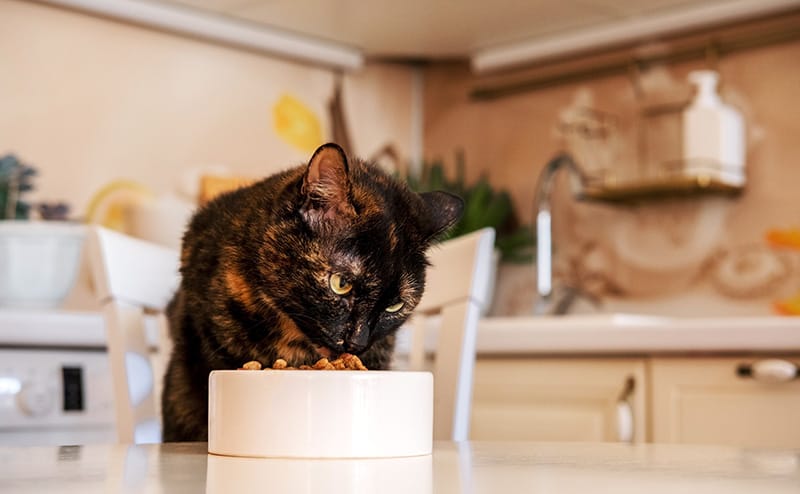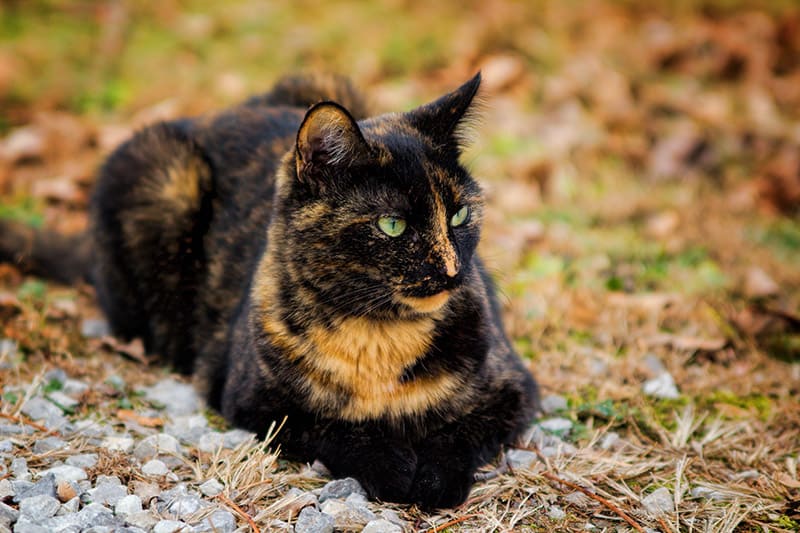Tortoiseshell Cats have a beautiful tapestry of wonderful interweaving colors!
The Tortoiseshell Cat is referred to as a Tri-Color cat, though in reality, this is not quite true. The defining feature of the classic tortoiseshell coat pattern is its color combination. This combination looks like black, red, and cream-colored hairs. Although it appears to be three colors, in reality, it consists of black areas and orange tabby areas. Since the orange tabby areas are two-toned, it creates the appearance of a three-toned cat.
Tortoiseshell coat colors can include red, brown, chocolate-toned brown, black, cinnamon, or cream. The tortoise shell pattern ranges from patches of color to a fine speckled patterning. The name “Tortoiseshell Cat” generally refers to those with an overall brindle coat, having very few or no white markings. They generally have numerous flecks of color that soften or nearly eliminate any clear boundaries between color sections.
The Tortie Cat is an interesting variation of the Tortoiseshell cat. These tortoiseshell color patterns have a mix of the tortoiseshell colors intertwined with a Tabby Cat patterning throughout. The Calico Cat, another very beautiful cat, is also a tortoiseshell. These are mostly white but with red and brown patches. They differ from the Tortie Cat in that the colors are solid blocks, but like the Tortie, the coat pattern can also include blocks with tabby markings. Cats with these types of coat markings are called a Calico Cat in the United States and a Tortoiseshell and White Cat in the United Kingdom.
- For more information on different types of cats, see: Types of Cats and Cat Breeds
Tortoiseshell Cat History
The factual history of the tortoiseshell coat pattern is not a glamorous one. The tortoiseshell pattern simply arose due to a combination of genetic traits, which is discussed below. However, there is some folklore the Khmers of Southeast Asia offer one interesting explanation. According to their folklore, the first tortoiseshell arose from the menstrual blood of a young goddess born of a lotus flower during a magical ritual.
There is also other interesting folklore concerning the tortoiseshell including the following:
- The Celts considered it a good omen if a male tortoiseshell stayed in their home.
- The English believed that warts could be healed if rubbed by the tail of a male tortoiseshell’s tail during May.
- Japanese fishermen believed that male tortoiseshells protected the vessel from ghosts and storms.
- Some others believed that having a tortoiseshell in one’s dream gives that person luck in love.
Tortoiseshell Cat Genetics
Many people mistakenly believe that all Tortoiseshells are female. While most Tortoiseshells are female, it is possible to find a male with the tortoiseshell pattern.
Gender genetics of tortoiseshell Cats:
- Female Tortoiseshell Cats – The reason that most Tortoiseshells are female is because both of the genes that produce this pattern are contained on the same part of the X chromosome. The red gene must be on one X chromosome and the non-red gene on the other. Since typical females have two X chromosomes and typical males have one X chromosome and one Y chromosome, it is obvious why this pattern is rarely seen in males.
- Male Tortoiseshell Cats – Most males can only have the red gene or the non-red gene, but not both. The resulting product is a solid red tabby or a solid black cat, rather than the combination of the two that comprises the tortoiseshell pattern. However, as mentioned earlier, not all Tortoiseshells are female. This occurrence is made possible by the fact that some males have two X chromosomes and one Y chromosome (XXY).
The genetic difference that causes a male tortoiseshell cat is rare, and is caused by a genetic error. It also results in a more feminine male cat. As a result, male Tortoiseshells are often less territorial or interested in females than typical males. They are also sterile. The rarity of the Tortoiseshell male cat may be the reason that so much folklore deeming them as good-luck charms exists.

Tortoiseshell Cat Markings
Tortoiseshell cat marking can range from color patches to fine color speckles. Coat colors can include red, black, dark and/or chocolate browns, cream and cinnamon. The term Tortoiseshell Cat is most commonly used to reference the tortoiseshell pattern which is an overall brindle coat with very few or no white markings. It has many flecks of color that effectively soften or nearly eliminate any clear boundaries between color patches. There are several basic variations of the tortoiseshell coat pattern that can be described as follows:
Tortoiseshell color pattern – without white markings:
- Tortie Cat – The Tortie is a combination of the tortoiseshell and tabby coat patterns. Torties have random patches of red, black, and cream. In this variation, the black sections are replaced by a dark tabby pattern and the patches can be mingled or more distinct. Another name used to describe this tortoiseshell color pattern is Tortie-tabby Cat.
- Dilute Tortie Cat – Blue Torties are randomly patched in blue and cream, giving them a more pastel coloration. Other names for this color pattern are Blue-cream Tortie and Blue Tortie.
- Brown Patched Tabby, also known as the Torbie Cat – This type of tortoiseshell has the tabby pattern in patches of brown and red.
- Blue Patched Tabby – Similar to the Blue Tortie, the Blue Patched Tabby has patches that are blue and cream but with the tabby pattern..
Tortoiseshell pattern – with white markings:
- Calico Cat – The Calico Cat is essentially is a tortoiseshell coat pattern with added white sections. They are white, but with red and brown patches. They differ from the Tortie Cat in that the black patches are solid, but like the Tortie, the coat pattern can also include tabby markings in the red patches. These types of cats are called the Tortoiseshell and White Cat in the United Kingdom and Calico Cat in the United States.
- Dilute Calico Cat – Like the Calico, the Dilute Calico is mostly white, but with colored patches of blue and cream. The blue patches are solid while the cream patches have the tabby markings.
- Caliby Cat – This version has a large amount of white but with larger distinct patches of color. Other names for this color pattern are Patterned Calico Cat, Calico Tabby Cat, Torbie and White Cat, Patched Tabby and White Cat
Tortoiseshell color pattern names:
The tortoiseshell pattern comes in many different color combinations… described by as many different names. These names include:: Blue Tortoiseshell, Chestnut Tortoiseshell, Chinchilla Shaded Tortoiseshell, Chocolate Tortoiseshell, Chocolate Tortoiseshell Point, Chocolate Tortoiseshell Lynx Point, Chocolate Tortoiseshell Shaded, Chocolate Tortoiseshell Smoke, Cinnamon Tortoiseshell, Cinnamon Tortoiseshell Smoke, Dilute Tortoiseshell, Dilute Chinchilla Shaded Tortoiseshell, Dilute Shaded Tortoiseshell, Ebony Tortoiseshell, Lilac Tortoiseshell, Seal Tortoiseshell, Shaded Tortoiseshell, Shell Tortoiseshell, Smoke Tortoiseshell, Tortoiseshell Point, Tortoiseshell Lynx Point, and Tortoiseshell and White (Calico).

Tortoiseshell Color Pattern Cat Breeds
Though the Tortoiseshell Cat is often mistaken as a breed, it is not a breed, but a coat pattern. However, the Tortoiseshell coat markings are accepted in many different breeds.
Domestic cat breeds that can exhibit tortoiseshell coat markings include:
- Natural Breed Cats
- Abyssinian Cat
- American Shorthhair Cat
- Birman Cat
- British Shorthair Cat
- Burmese Cat
- Burmilla Cat
- Colorpoint Shorthair Cat
- European Shorthair Cat
- Himalayan Cat
- Japanese Bobtail Cat
- Maine Coon Cat
- Norwegian Forest Cat
- Persian Cat
- Siamese Cat
- Turkish Angora Cat
- Turkish Van Cat
- Mutation Cat Breeds
- American Bobtail Cat
- American Curl Cat
- American Wirehair Cat
- Cornish Rex Cat
- Cymric Cat
- Devon Rex Cat
- Manx Cat
- Scottish Fold Cat
- Somali Cat
- Sphynx Cat
- Hybrid Cat Breeds
- Exotic Shorthair Cat
- Oriental Shorthair Cat
- Tonkinese
Exotic Cats, those that are wild cat species, are not generally described with a tortoiseshell coat pattern. There is one exception suggested in an early piece of literature entitled “A Tortoise-shell Wild Cat” by William H. Ballou, 1897. The Tortoiseshell Wildcat Felis Bracatta was said to inhabit the jungles of southern Brazil, but today there is no living example of this species.
Featured Image Credit: Cheryl Toepfer, Shutterstock
